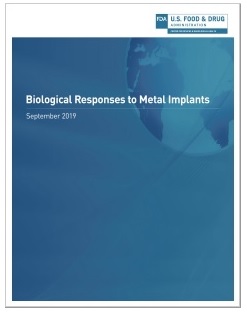Metals and metal alloys are commonly used in implanted medical devices and in inserts like amalgam dental fillings, and these materials are sometimes in contact with parts of the body for extended periods of time. Part of the FDA’s evaluation to determine whether a medical device is safe and effective involves reviewing information about metals and other materials used in the device.
- Concerns About Immune Responses to Metal in Medical Devices
- Metal-Containing Implants
- Dental Amalgam
- Determining Medical Device Material Safety
- More FDA Information on Metals in Medical Devices
Participate in the Immunology Devices Panel Meeting in November 2019 – see more at
https://www.fda.gov/medical-devices/products-and-medical-procedures/metals-used-medical-devices?utm_campaign=2019-09-30%20Metal%20Implants%20and%20Dental%20Amalgam&utm_medium=email&utm_source=Eloqua
On November 13-14, 2019, the FDA will host a public meeting of the Immunology Devices Panel of the Medical Devices Advisory Committee to discuss metal-containing implants and dental amalgam. Read the FDA’s paper on metal-containing implants and paper on dental amalgam for more information on the topics.
The FDA has heard concerns raised by patients and other device users, and we have received adverse event reports that note biological responses to certain metals used in medical devices. Based on our evaluation, we believe the current evidence, although limited, suggests some individuals may be predisposed to develop a local or systemic immune or inflammatory reaction when exposed to certain metals contained in select implantable devices.
The symptoms some people have noted may be limited to the region where the device is implanted or may be more generalized. Reported systemic symptoms include fatigue, rash, joint and muscle pain, and weakness. Although uncommon and varied, these symptoms can sometimes mimic more well-established inflammatory conditions, such as systemic lupus erythematosus.
The science around immunes response to materials in medical devices is expanding and furthering this science to improve patient treatment options and outcomes is a priority for the FDA. Lab tests commonly used to diagnose allergy-based sensitivities may not be adequate to identify susceptible individuals. To better understand how a patient responds to materials used in medical device implants and harness that information to improve the safety of devices in patients, the FDA is working to engage the public—in particular, scientists, patients, and health care providers—and industry stakeholders to determine the current state of the science, critical gaps in the existing science, and what approaches the FDA should consider.
See more at:


